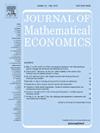Factor substitution and economic growth in a Romer-type model with monopolistic competition
IF 0.7
4区 经济学
Q3 ECONOMICS
引用次数: 0
Abstract
This paper studies the relationship between the elasticity of factor substitution (EOS) and steady-state values in a simplified Romer-type model with an expanding variety of products. Final goods production uses a nested CES technology, allowing substitution both among intermediate goods and between a composite intermediate good and labor. Consumption is a fixed fraction of output, and the cost of new intermediate production is constant and exogenous. The existence of an interior steady state requires an EOS between labor and the composite intermediate good above one, and an EOS among intermediates that exceeds the output–consumption ratio. Under these conditions, for a developing economy with an increasing variety of products, a higher EOS between labor and the intermediate composite good results in lower per capita output. This finding contrasts with results from infinite-horizon growth models, where a higher capital–labor EOS tends to boost per capita income (or the long-run growth rate) if baseline capital per capita is below its steady-state level. If the EOS between labor and the intermediate composite good is below unity and income per capita converges asymptotically to a constant as the number of intermediates continues to grow without bound, the usual positive relationship between the EOS and income per capita reappears.
垄断竞争下romer模型中的要素替代与经济增长
本文研究了一个产品种类扩大的简化romer模型中要素替代弹性(EOS)与稳态值之间的关系。最终产品生产使用嵌套CES技术,允许中间产品之间以及复合中间产品和劳动力之间的替代。消费占产出的比例是固定的,而新的中间产品的成本是恒定的和外生的。内部稳态的存在要求劳动与复合中间产品之间存在EOS,中间产品之间存在超过产出消费比的EOS。在这些条件下,对于一个产品种类越来越多的发展中经济体来说,劳动力和中间复合商品之间的EOS越高,人均产出就越低。这一发现与无限视界增长模型的结果形成对比,在无限视界增长模型中,如果基线人均资本低于其稳态水平,较高的资本-劳动EOS往往会提高人均收入(或长期增长率)。如果劳动和中间复合商品之间的EOS低于1,并且随着中间产品数量的不断增长,人均收入渐近收敛于一个常数,则EOS与人均收入之间通常的正相关关系再次出现。
本文章由计算机程序翻译,如有差异,请以英文原文为准。
求助全文
约1分钟内获得全文
求助全文
来源期刊

Journal of Mathematical Economics
管理科学-数学跨学科应用
CiteScore
1.70
自引率
7.70%
发文量
73
审稿时长
12.5 weeks
期刊介绍:
The primary objective of the Journal is to provide a forum for work in economic theory which expresses economic ideas using formal mathematical reasoning. For work to add to this primary objective, it is not sufficient that the mathematical reasoning be new and correct. The work must have real economic content. The economic ideas must be interesting and important. These ideas may pertain to any field of economics or any school of economic thought.
 求助内容:
求助内容: 应助结果提醒方式:
应助结果提醒方式:


